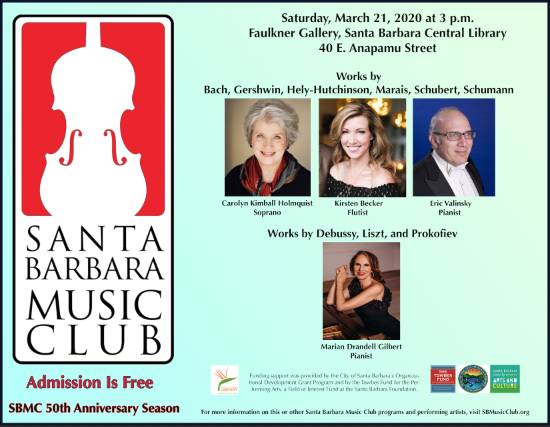CANCELED – S.B. Music Club 50th Season Free Concert – CANCELED
 Faulkner Gallery - Santa Barbara Central Library
Faulkner Gallery - Santa Barbara Central Library
**Events may have been canceled or postponed. Please contact the venue to confirm the event.
Date & Time
Sat, Mar 21 3:00 PM - 4:30 PM
Address (map)
40 E. Anapamu Street, Santa Barbara
Venue (website)
Faulkner Gallery - Santa Barbara Central Library
THIS EVENT HAS BEEN CANCELED
On Saturday, March 21 at 3 p.m., the Santa Barbara Music Club will present another program in its popular series of concerts of beautiful Classical music. Soprano Carolyn Kimball Holmquist, flutist Kirsten Becker, and pianist Eric Valinsky will feature vocal works by J.S. Bach, Franz Schubert, Frank Martin, George Gershwin, and Claude Bolling. Marian Drandell Gilbert concludes the program with solo piano music by Claude Debussy, Franz Liszt, and Sergei Prokofiev. This concert, co-sponsored by the Santa Barbara Public Library, will be held at the Faulkner Gallery of the library, 40 East Anapamu, Santa Barbara. Admission is free.
Soprano Carolyn Kimball Holmquist, flutist Kirsten Becker, and pianist Eric Valinsky
Open the program with a star-studded compilation of well-known, adored works. The first two pieces enjoy most notoriety within church services, weddings, and Marian devotions: Sheep May Safely Graze by J.S. Bach (1685–1750) and Franz Schubert’s (1797–1828) lied Ave Maria. Next, the set Trois chants de noel comprises three Christmas songs by the twentieth-century Swiss composer Frank Martin (1890–1974). Although not as well known as other works on the program, the songs feature Martin’s late, mature style, which combines the sensual melodic lines of French Impressionism and twelve-tone techniques like that of Schoenberg. Next comes three selections by George Gershwin (1898–1937)—“S Wonderful,” “Fascinatin’ Rhythm,” and “I Got Rhythm.” Each song originally comes from a Broadway musical: Funny Face (1927), Lady Be Good (1927), and Girl Crazy (1930), respectively. Eric Valinsky and Becker complete their set with an excerpt from French pianist and composer Claude Bolling’s (b. 1930) Suite for Flute and Jazz Piano. The suite originally comprises seven short movements, which fuses classical techniques and styles, as demonstrated in the flute part, and a jazz sonorities and rhythms for the piano. Each performer runs the stylistic gamut, ranging from Baroque to Jazz in this eclectic selection of pieces.
French composers have a long tradition of writing fiery toccatas in the keyboard tradition. Translated roughly to “touch piece” and originating in the late sixteenth century, the toccata became a free flight of fancy: a vehicle for performers to showcase their technical prowess. The Symbolists and Impressionists of fin-de-siècle France continued this tradition and composed extremely demanding and opulent works. Claude Debussy (1862–1918) included a toccata as the third and final piece of his 1903 Estampes (Prints), titled “Jardins sous la pluie” (“Gardens in the Rain”). Debussy wrote relentless, rapid passages – typical of toccatas – to suggest a rainstorm, from which emerges excerpts of two French folk songs, Nous n’irons plus aux bois (“We Will Not Return to the Woods”) and Dodo, l’enfant do (“Sleep, Child, Sleep”). Marian Drandell Gilbert thus begins the second half of the program with an inundation of sonority and movement.
She continues with another work incorporating virtually perpetual motion that has an altogether different mood, the famous “Un Sospiro” (“A Sigh”) from the Trois études de concert, S.144, by Franz Liszt (1811–1888). Liszt composed these three studies between 1845–1849, and each takes a different character while requiring different technical capabilities. For this piece, performers must divide a beautiful pentatonic melody between the hands, which requires several hand crossings. Although the pianist’s hands leap across the keyboard and suggest pyrotechnic abilities, the result is an ironically calm and peaceful musical utterance. Due in part to the sweeping melody and accompaniment, Un Suspiro has become the most popular among the three etudes and among the most beloved of Liszt’s compositions.
Gilbert completes her program with the short but fiendishly challenging Piano Sonata No. 3 in A Minor, Op. 28 by Sergei Prokofiev (1891–1953). The composer wrote this single-movement sonata in 1917, which traces to ideas he began sketching in a notebook as a teenager. In signature Prokofiev style, the piece opens with an aggressive attack of chords and a jagged melody that encompasses a wide range on the keyboard. The sonata, however, requires expressive control as its mood, tempo, and character change frequently and suddenly. Also true to Prokofiev’s style, the work never fails to thrill.
Santa Barbara Music Club concerts are free to the public, and display a wonderful diversity of historical musical periods and compositional styles, including beloved masterworks and exciting new and seldom-heard repertoire. Of the series, the Santa Barbara Independent exclaimed: “A beautiful day, a beautiful room, beautiful music … who could ask for more?” and Gerald Carpenter in Noozhawk.com declared, “Every Santa Barbara Music Club concert that I have ever attended has been a sensory joy as well as a consciousness expansion.”
A valued cultural resource in the community since 1969, the Music Club’s mission is threefold:
(1) Presentation of an annual series of concerts, free to the public.
(2) Aiding and encouraging musical education by the disbursement of scholarships to talented local music students.
(3) Presentation of community outreach activities, including bringing great music to residents of area retirement homes.
For information on this or other Santa Barbara Music Club programs and performing artists, visit SBMusicClub.org.
